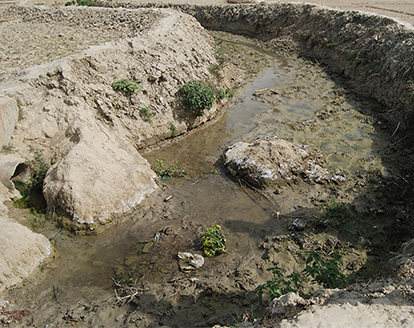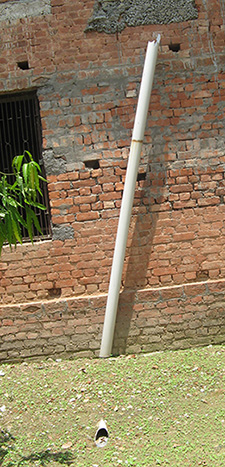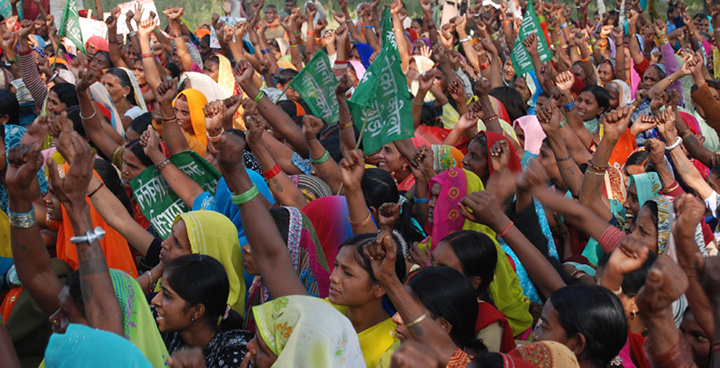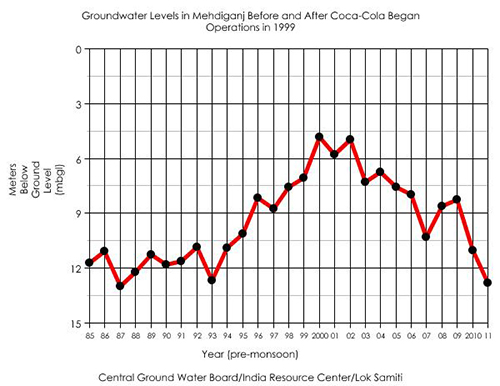|
|
|
Home--Campaigns--Coca-Cola
Mehdiganj - The Issues
India Resource Center
October 26, 2014
The Coca-Cola company has located one of its bottling plants in Mehdiganj, a rural and agrarian area located about 25 kms from the city of Varanasi, in east India. Coca-Cola’s bottling plant, which has been in operation since 1999, has severely damaged the groundwater resources in the area – both through over-exploitation as well as pollution of groundwater and the soil.
 Coca-Cola Factory in Mehdiganj
Coca-Cola Factory in Mehdiganj
Credit: India Resource Center | |
The community in and around Mehdiganj also rely on the same groundwater – a common resource – to meet all their water needs, including drinking, cooking, cleaning, providing water for livestock, as well as agriculture – the primary activity and occupation in the area. Coca-Cola’s plant in Mehdiganj has been the target of protests since 2003, with local communties and allies demanding that the company shut down its plant because it is unsustainable.
2014 has been a momentous year for the campaign and we expect more positive developments as the campaign continues to exert pressure on both the Coca-Cola company as well as the local, state and national government authorities.
On June 6, 2014, the pollution regulatory agency – who we worked closely with to make the case against Coca-Cola – ordered the closure of Coca-Cola’s bottling plant due to violations of the terms of its license. Coca-Cola has appealed the closure notice and is able to temporarily operate its plant while the courts hear the case.
And in another major setback for Coca-Cola, the government rejected the company’s application to expand its bottling plant in Mehdiganj in August 2014. The India Resource Center has led the campaign to ensure that Coca-Cola’s application for expansion was rejected. Coca-Cola has already fully built the plant - at a cost of US$25 miilion - in anticipation of getting the license.
In spite of the growing evidence against the company, Coca-Cola continues to deny that it has anything to do with the sharp fall in groundwater levels and pollution in Mehdiganj. Coca-Cola has also embarked upon a very ambitious (and dubious) public relations exercise to counter the growing opposition to its plant – corporate social responsibility programs claiming to conserve water.
Protests against the Coca-Cola company in Mehdiganj continue to grow and the community’s position is clear. The groundwater resource in Mehdiganj cannot meet the needs of both the community and the Coca-Cola’s bottling plant. One has to go, and it must be the Coca-Cola company.
Water
Government data confirm the community claims that groundwater levels have dropped sharply ever since Coca-Cola began operations in Mehdiganj in 1999.
Farmers in the area, who are keenly aware of groundwater conditions because their lives and livelihoods depend on it, started noticing the groundwater levels dropping almost immediately after Coca-Cola began operations. Wells in the villages started to run dry, water hand pumps stopped working and ponds in the area also dried up.
Coca-Cola is the single largest user of groundwater in the area, and that too by a considerable margin. No farmer comes even close to using so much groundwater.
Seasonal Water Use Exacerbates Water Stress
It is important to note the seasonal nature of Coca-Cola’s groundwater extraction and the monumental stress it puts on the aquifer. In India, most of the soft drinks produced by Coca-Cola are consumed in the summer months. As a result, 70% of Coca-Cola’s annual production occurs in just the four months of March, April, May, June – exactly when the groundwater levels are at their lowest and water scarcity for the community at its acutest. The practice of extracting the largest amounts of water during the summer months exponentially increases the hardships faced by the community as a result of an already depleted aquifer.
In Mehdiganj, Coca-Cola has extracted nearly a million liters of water on a single day in the summer!
Agricultural Water vs Bottled Water
There is also an important difference in the use of groundwater by Coca-Cola and the farmers in Mehdiganj. Farmers use the groundwater locally to grow crops which are used to sustain themselves through nutrition and making a living by selling crops in the markets. Most of the groundwater used by farmers goes back into the local aquifer. Coca-Cola, on the other hand, extracts the groundwater, and after treating and bottling it, transports it away from the local aquifer to sell it for profit.
In 2012, under pressure from the campaigns in Mehdiganj, the Central Ground Water Board of India, a government agency, conducted a study on the impacts of Coca-Cola’s operations in Mehdiganj. The study found, unsurprisingly, that the groundwater levels at the Coca-Cola factory were the lowest in the area, and the study labeled Coca-Cola’s groundwater use as “excess”.
In 2009, the government of India declared the groundwater conditions in and around Mehdiganj as critical, and as a result, restrictions have been placed on the use of groundwater in the area – which mostly impact famers.
Coca-Cola, however, continues to mine groundwater in Mehdiganj to make Coca-Cola products, even as farmers and the community are left with less and less water as a result of Coca-Cola’s excessive groundwater extraction.
Some of the water that Coca-Cola extracts has accumulated in the aquifer over thousands and thousands of years. We simply cannot allow this company to take this water so that future generations will have no water, and as a result, destroyed lives and livelihoods.
Coca-Cola’s bottling operations in Mehdiganj comes at a high price for both the current and future generations in Mehdiganj, and they violate the principles of sustainable development – development that meets the needs of the present without compromising the ability of future generations to meet their own needs.
Coca-Cola’s water mining in Mehdiganj must be stopped.
Pollution – The Untold Story
Although Coca-Cola does not volunteer its daily and monthly water use in Mehdiganj, we have been able to access some numbers provided by the company which paint a bleak picture.
Waste Water
In the month of May 2004, for example, Coca-Cola extracted nearly 20 million liters of water (averaging nearly 670,000 liters per day) in Mehdiganj. In the same month, it produced 5 million liters of product. In other words, it took Coca-Cola 20 million liters of groundwater to produce 5 million liters of Coca-Cola products. What happened to the 15 million liters of groundwater that was not accounted for in its products? It was converted into wastewater.
 Effluents Discharging into Local Drain in Mehdiganj
Effluents Discharging into Local Drain in Mehdiganj
Credit: India Resource Center | |
The wasteful manner in which Coca-Cola utilizes groundwater is a story that Coca-Cola would like to keep hidden. The wastewater, which is generated as a result of the production process, has been contaminated with various chemicals that Coca-Cola uses in its production process, and the effluent must be treated according to government regulations.
In Mehdiganj, the effluents from the Coca-Cola factory are directed into a drainage which feeds directly into the river Ganges, a river considered sacred by Hindus. The effluents also leach back into the groundwater, contaminating the groundwater.
Toxic Waste
In 2003, the Central Pollution Control Board of India sampled the waste from nine Coca-Cola bottling plants across India and found that ALL nine plants were violating the hazardous waste rules and regulations of India. The Central Pollution Control Board found that the effluents and sludge from all nine bottling plants had exceeded levels of either cadmium, chromium and lead (and sometimes more than one).
In the case of Mehdiganj, the Central Pollution Control Board found excessive levels of cadmium, chromium and lead in samples of sludge that it had tested from the HCCBPL bottling plant. It is only after this finding that Coca-Cola was ordered to treat its waste as hazardous waste.
The Central Pollution Control Board undertook the study after pressure from communities across India accusing Coca-Cola of pollution, as well as reports from the communities that Coca-Cola was giving away their toxic sludge as fertilizer to farmers in the area. Coca-Cola was ordered to stop the practice of distributing its toxic fertilizer after the study.
In 2004, the solid waste from one of Coca-Cola’s bottlers in the state of Punjab was also found by the state pollution authority to contain excessive levels of heavy metals, including cadmium – at eight times the limits allowed for it to be classified as hazardous waste.
Since 2005, two prominent NGO’s – the People’s Science Institute (2006) and the Energy and Resources Institute (2008) have also conducted studies on pollution and found contamination in the groundwater as one gets closer to Coca-Cola’s factory.
One of Coca-Cola’s largest bottling plants in India, in Plachimada in the state of Kerala, has been shut down since March 2004 because Coca-Cola is unable to obtain a clearance from the state pollution authorities which had ordered the Coca-Cola plant to “stop production” due to the presence of heavy metals such as lead, cadmium and chromium. In 2011, the state legislature of Kerala passed a law seeking at least US$ 47 million in damages caused by Coca-Cola’s operations in the area.
In 2011, the state pollution authorities in the state of West Bengal also found Coca-Cola in violation of the hazardous waste regulations in India, which the company states it has later corrected. A court however has ordered in 2012 that further tests be conducted by the state pollution authority.
Coca-Cola’s pollution continues across India and is a serious public health issue. Heavy metals such as lead, cadmium and chromium have severe impacts on humans and animals, and it can take a long time for the impacts to be felt.
Coca-Cola’s Response – Rainwater Harvesting
The Coca-Cola company has responded by embarking upon a very ambitious (and dubious) public relations exercise to counter the growing opposition to its plant – corporate social responsibility programs claiming to conserve water.
Coca-Cola's Rainwater Harvesting - Dilapidated, Ineffective and a PR Ploy
The community of Mehdiganj and other communities across India have witnessed and documented Coca-Cola’s attempts to recharge groundwater through rainwater harvesting. Coca-Cola’s rainwater harvesting initiatives do not work, and they do not “offset” Coca-Cola’s groundwater use.
 Coca-Cola's Rainwater Harvesting in Mehdiganj
Coca-Cola's Rainwater Harvesting in Mehdiganj
Credit: Lok Samiti | |
Many of Coca-Cola’s rainwater harvesting initiatives, which in reality they outsource to others, simply do not work because they are not well built and they are ill maintained. The Energy and Resources Institute, in a 2008 study that looked at Coca-Cola’s operations in six areas, including Mehdiganj, described Coca-Cola’s rainwater harvesting structures as “dilapidated”.
A March 2012 report by the Central Ground Water Board of India also noted that Coca-Cola’s rainwater harvesting structures in Mehdiganj (of which only two were located in the factory) “don’t have any bearing on the pumping of water being carried out by the factory.”
Water issues are local issues. One cannot deplete an aquifer locally and recharge another aquifer far away and claim that everything is “water neutral”, as Coca-Cola claims.
Even Coca-Cola company officials in Mehdiganj admit that their rainwater harvesting initiatives have been a failure. They admitted to the Central Ground Water Board in 2012 that the “desired impact is not visible in the area.”
If Coca-Cola is so confident of its rainwater harvesting initiatives in Mehdiganj, why doesn’t Coca-Cola use rainwater alone to meet its productions needs in Mehdiganj?
Coca-Cola’s claims of successful rainwater harvesting to recharge the groundwater in Mehdiganj are simply not true and are designed as a public relations ploy to deflect attention from the fundamental problem – Coca-Cola’s mining of water in water stressed areas.
Campaign
The community in and around Mehdiganj impacted negatively by Coca-Cola’s activities have organized themselves to apply pressure on the Coca-Cola company and the Indian and state government to shut down Coca-Cola’s bottling plant in Mehdiganj. The community is demanding that:
- Coca-Cola’s bottling plant in Mehdiganj be shut down immediately
- Coca-Cola be held liable for compensating the famers and community members who have lost livelihoods as a result of the depleted groundwater and pollution
- Coca-Cola pay for the remediation and clean-up of the groundwater and soil
- Criminal charges be brought against Coca-Cola to hold it accountable for knowingly damaging the groundwater and pollution in violation of laws in India
- Coca-Cola be held responsible for the retraining and relocation of the workers (permanent and contract) who will be laid off as the result of the shut down
 Protest in Mehdiganj to Shut Down Coca-Cola
Protest in Mehdiganj to Shut Down Coca-Cola
Credit: India Resource Center | |
|
|


PRESS: Coca-Cola Forced to Abandon $25 Million Project in India
PRESS: Coca-Cola Expansion Plans Rejected
PRESS: Coca-Cola Plant Shut Down in India, Authorities Cancel License
STUDY: Coca-Cola’s Operations in India Lead to “Tragedy of the Commons”
PRESS: 15 Village Councils Reject Coca-Cola Plans as Opposition Grows
Mehdiganj - The Issues
PRESS: Coca-Cola Expansion Plan Opposed in Mehdiganj, India
Support Us
Join Us
>> More
Stories

|

![]()




